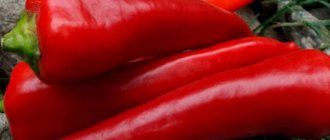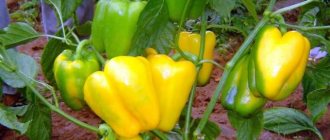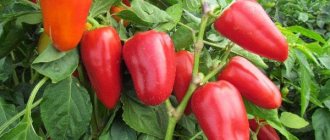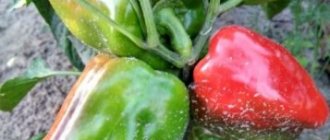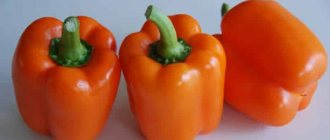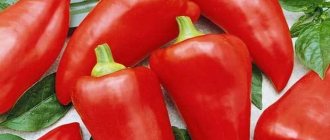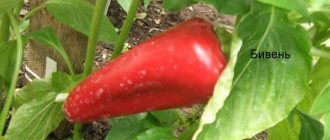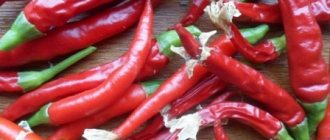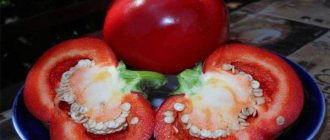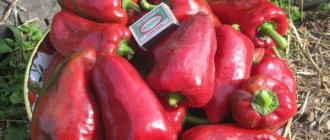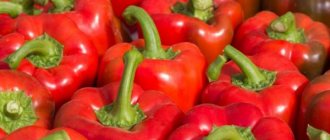Vegetable growing » Pepper
0
1089
Article rating
Kira Stoletova
The Zorka pepper variety is one of the most popular among sweet varieties. Zorka pepper is valued for its excellent taste and high yield.
Characteristics of the Zorka pepper variety
Characteristics of the pepper variety Lesya
According to the characteristics, Lesya pepper is a high-yielding variety with high immunity, grows well in regions with difficult climates and is suitable for growing in mixed soils.
Description of the bushes
The bush is medium-sized, reaching up to 75 cm in length. The branches spread out in all directions. There are many leaves, they are smooth and the same size as the fruit. There are a lot of fruits growing on the branches, so they can break. Lesya matures in 120 days. Up to 30-35 fruits grow on the bush at the same time.
Description of fruits
According to the description, the pepper fruits have the shape of a drop with a long tip. The weight of one fruit is up to 180 g. The wall thickness is 1 cm. Lesya pepper is bright red. Its skin is smooth and shiny. The pulp is sweet, juicy, tasty and aromatic.
Before landing
Lesya sweet pepper can be grown both in open and indoor soils. The seeds are prepared before planting: soaked in a solution of minerals, nutrients and water. For planting, choose high-quality and healthy soil. The best place for further growth is a greenhouse.
After landing
The seeds are planted at the end of winter, but they cannot be buried more than 2.5-3 cm. Afterwards, lightly water the soil. At this stage, the most favorable temperature for growth is 25°C. After a couple of weeks, sprouts appear; the best temperature for them is 18°C.
After planting, the plant is watered regularly. After the soil dries, watering is carried out.
There should be no weeds or residues from other plants near the bush.
The use of fertilizers helps vegetable crops to develop. A good option for feeding is 0.1 kg of mullein per 1 liter of water. It is not recommended to fertilize more than 2 times a month.
Peppers must be fertilized
Fungus
The most common type of disease in nightshades is fungal.
- Verticillium is a fungal disease. When infected with Verticillium, all leaves turn yellow and become limp. The disease cannot be cured, therefore, when even the first symptoms appear, the affected bush is destroyed.
- Stolbur is an infectious disease that causes yellowing, rotting and curling of leaves. The fruits become crooked and fail to ripen. Stolbur causes the death of the bush. The disease cannot be treated, so the diseased bush is destroyed. Stolbur is caused by insects that carry the infection.
- Cladosporiosis. The entire plant becomes covered with large brown spots, and the bush begins to rot. To cure, stop watering the plant, remove the infected parts, and treat it with a solution of foundationazole and water (1 liter of water, 20 liters of foundationazole).
Pests
- The Colorado potato beetle is an insect reaching 10 mm in length. The body of the beetle is shiny, brown-orange in color with black stripes. The Colorado potato beetle has developed wings, so it can fly over long distances. The beetles feed on the leaves of the bushes and cause their death. To combat, spray with a solution of water and wood ash (1 kg of ash per 5 liters of water).
- The slug is a brown-gray mollusk that moves by crawling and leaves behind trails of mucus. Slugs feed on the leaves of bushes and spoil the fruits. There is one simple and effective way to combat slugs - manually. Its use involves inspecting the bushes for the presence of these pests and collecting them. Slugs often hide in the shade and in damp places.
- Aphids are small bugs and are difficult to notice. This harmful green insect drinks the sap of the plant. Aphids reproduce faster than other pests. A solution of wood ash and water is used against it (1 kg of ash per 5 liters of water).
- Spider mites are small red beetles.
He drinks the sap of plants and leaves behind a web. Spider mites hide under leaves. To combat it, it is recommended to spray them with a solution of soap and water (50 g of soap per 1 liter of water).
If carelessness has been shown, and the pests have managed to multiply greatly, they begin to use high-quality chemicals for control.
The use of such drugs is expensive, so it is important to notice the first appearance of pests. Careful inspection of plants for their presence helps in pest control.
It’s good to make an inspection plan so you know in advance which places to look.
Careful inspection of plants for their presence helps in pest control. It’s good to make a viewing plan so you know in advance which places to look.
For open ground
Sweet peppers can be grown in open areas, but for this, the planting material must be resistant to weather conditions, which change from time to time.
Pepper variety Lydia
Many years ago, we appreciated the excellent taste and good keeping quality of these varieties. The Lydia variety is ideal for preparing salads and preparations. Also for long-term storage; because it is thick-walled, perfectly meaty and juicy, it does not flab for a long time, remaining fresh. And lecho prepared from the fruits of this variety is simply delicious. This is a mid-season variety, the fruits of which will be on your table three months after sowing the seeds.
The plant itself is not very tall, approximately 50-70 cm, while the fruits weigh more than 360 g. Fruits very abundantly - 5-7 kg per bush during the growing season. At technical ripeness, the fruit has a green or green color with a slight purple tint. When ripe, with full biological ripeness, they become rich red.
Sweet pepper - varieties for the Urals
Many varieties of pepper are suitable for the Urals. In Bashkortostan, Kurgan region, Orenburg and Chelyabinsk regions you can grow:
- ROMANTSOV'S FIRST-BORN
- GOLDEN CALF
- FRESHNESS
- BEAR
- MARTIN
- SIBERIAN BONUS
- FATHER FROST
- SIBERIAN FORMAT
- GOLIATH
- EUROPEAN
- GOTHIC
- Rizhik
- COLD
- HONEY KING
- AN EARLY MIRACLE
- KUBOVICH
- OPENWORK
- ELEPHANT
- NUGGET OF THE EAST
- LUCK
- ISTRINKA
- PEKINGESE
- FIGHTER
- CANDLE
- SUCCESSFUL
- CHIP
- DMITRIY
- VYATICH
- CHAPAI
- ORANGE GOURMAR
- DOMINATOR
- MAGELLAN
- DELIGHT
- MARQUIS
- TACITUS
- SPARTA
- FLAVIUS
- PALERMO
- GLADIATOR AGRO
- TURQUOISE
- GOLDEN BARREL
- ZYATEK
- OCCUPATION NEW YEAR
- HANDSOME MAN OF PRIOBIE
- GARNET BRACELET
- VON BARON ORANGE
- GENEROSITY
- ZADOR
- GOLD AUTUMN
- KAKADU YELLOW
- RED NOSE
- GOLDEN CUP
- CUBANO
- RUBY CUP
- TEQUILA
- LOTTA
Pepper varieties for the Urals - description
Sweet pepper FIRST-BORN ROMANTSOVA
The variety is suitable for growing in open ground and under temporary film covers. Early ripening.
The period from full germination to the beginning of technical ripeness of the fruit is 80-112 days.
The plant is standard, semi-spreading, medium-leaved, 45-55 cm high.
The fruit is drooping, cone-shaped, glossy, yellowish in technical ripeness, red in biological ripeness. Number of nests 3-4. The thickness of the fetal wall is 3.5-4.2 mm (up to 7 mm). Fruit weight is 32-67 g (up to 90 g). The taste is good to excellent. The aroma is weak.
Variety FRESHNESS
The variety is suitable for growing in open ground and under film covers. Early ripening. The period from full germination to the beginning of technical ripeness of the fruit is 99-112 days.
The plant is semi-spreading, medium-leaved, 55-65 cm high.
The fruit is drooping, prism-shaped to cone-shaped, smooth, glossy, yellowish in technical ripeness, red in biological ripeness.
Number of nests 3-4. The thickness of the fetal wall is 4.0-4.5 mm. Fruit weight 32-68 g. Taste is good to excellent. The aroma is weak. The yield of marketable fruits in open ground is 0.8-1.8 kg/sq.m, maximum - up to 7 kg/sq.m. m (Krasnoyarsk region).
Sweet pepper variety GOLDEN CAURUS
The variety is suitable for growing in open ground and under film covers. Mid-season.
The plant is semi-spreading, of medium height.
The fruit is drooping, cube-shaped, highly glossy, dark green in technical ripeness, dark orange in biological ripeness.
Number of nests 3-4. Fruit weight is 104-173 g, wall thickness is 7-10 mm, the taste is good and excellent, the aroma is average.
Variety BEAR
Suitable for growing in open ground and under film covers. Medium early variety.
The plant is closed and tall.
The fruit is drooping, cylindrical, long, highly glossy, the color is green at technical ripeness, dark red at biological ripeness.
Number of nests 3-4. Fruit weight 128 g, wall thickness 9-10 mm. The taste of fresh fruit is excellent. The yield of marketable fruits under film covers is 3.0 kg/sq.m, in open ground - 1.8 kg/sq.m.
Santa Claus variety
Suitable for growing in open ground and under film covers. The variety is early ripening. The plant is semi-spreading, of medium height.
The fruit is drooping, cylindrical, highly glossy, the color in technical ripeness is dark green, in biological ripeness it is dark red.
Number of nests 3-4. Fruit weight 100-120 g, wall thickness 6-7 mm. The taste of fresh fruit is excellent. The yield of marketable fruits under film covers is 7.0-8.2 kg/sq.m.
Sweet pepper variety SIBERIAN BONUS
The variety is intended for cultivation in open ground and under film covers. The variety is mid-season.
The plant is spreading, of medium height.
The fruit is drooping, cube-shaped, green in technical ripeness, dark orange in biological ripeness. Number of nests 3-4. Fruit weight 100-110 g, wall thickness 6-8 mm. The yield of marketable fruits under film covers is 5.5-6.7 kg/sq.m.
Tall
This group includes vegetable crops that have a tall bush. In this case, care should involve not only irrigation, loosening, but also tying up the crop.
Arrogant
The bush height of this plant reaches 1 m. At the ripe stage they have a bright red color. The shape of the product is heart-shaped and prism-shaped. It can weigh 160-250 g.
In one season you can collect 15 pieces from one bush. Zaznaika is a vegetable crop that is characterized by juiciness and meatiness. The growing process takes place in open areas.
Zorka
A tall plant that ripens early. Large, and their color is scarlet. The pulp is characterized by sweetness and juiciness.
Atlantic F1
An early-ripening hybrid with elongated, fleshy legs. Their sizes are quite large, the weight of one pepper can reach 300-500 g. The color of the product is dark red.
Cardinal F1
The hybrid is also included in the tall group. Characterized by their high meatiness. The weight of one pepper reaches 250 g. The color is purple.
Red elephant
An early ripening tall crop with an elongated conical shape. The size of the vegetable is average, the weight of one will be 130-210 g. It has a dark red color scheme.
Orange miracle F1
A high-yielding early-ripening variety, the height of which is 110 cm. They are characterized by their fleshiness and bright orange color. The weight of one pepper reaches 250 g.
Triton
This crop is characterized by a very early maturity. The shape is cone-shaped, the dimensions are medium. The weight of one pepper reaches 150 g. The color of the vegetable is red.
The variety has early ripening. Depending on the degree of ripening, it changes color from yellow to orange.
ox ear
The crop is mid-season, the shape is presented in the form of an elongated cone. The weight of one pepper reaches 115-140 g. A mature specimen has a dark red color.
Barguzin
The bush is large. Ripe species are yellow or light orange in color. The shape of the pepper is presented in the form of a narrow, elongated cone. The weight of the ripe product reaches 150 g.
If favorable growing conditions have been created, then in one season it is possible to collect 15-18 juicy pieces. This type of crop adapts perfectly to different growing conditions.
Cornet
The bush height of this plant reaches more than 1 m. A ripe specimen has a dark brown color. The shape of the fruit is presented in the form of a cone. The mass of one is 200-250 g.
The quality of fruiting depends on the conditions in which the crop was maintained. Continuous fruiting is achieved throughout the entire growing season.
The video shows early varieties of sweet peppers for open ground:
Today there are a large number of different varieties of sweet peppers. Choosing the right one is very easy if you know the characteristics of each in advance. If you still cannot decide on the appropriate variety, then you should get advice from a specialist.
General form
Zorka pepper can be called one of the most popular varieties. The variety is successfully grown by gardeners in various regions of Russia. Pepper is valuable for its resistance to the vagaries of weather and high yield.
The plant looks like this:
16 excellent varieties of plums for the Moscow region
- Semi-spreading bush up to 50 cm high.
- The leaves are medium sized, green, with barely noticeable wrinkles. There are few plates along the stem.
- Flowers of a common type for cultivation.
- 10-15 ovaries are formed on 1 plant.
- The fruits are drooping. The shape approaches a prism.
- The skin is smooth and glossy.
- Average weight – 130 g. With enhanced agricultural technology, specimens up to 200 g are obtained.
- At the initial stage of ripening, the pepper is milky yellow in color. Fully ripe – bright red (pictured).
- The taste of the fruit was highly appreciated by tasters. Pepper is used universally in the kitchen.
| Type of growth, bush height | Determinate, 45-50 cm |
| Ripe fruit color | Intense red |
| Planting scheme | 40x50 cm |
| Weight, length and shape of the fruit | 100-130 g, up to 12 cm, prismatic |
| Ripening period, yield | Early ripening (90-95 days). In a greenhouse up to 10 kg/m2. In exhaust gas up to 8 kg/m2 |
| Drop off point | exhaust gas/greenhouse/greenhouse |
| Diseases | Resistant to root rot, tolerant to powdery mildew and ascochyta blight |
| By type of use | Universal |
| Flowering type | Female |
Pepper Sun - description and characteristics of the variety
The variety is an early ripening variety; harvesting can be done 110 days after planting the seedlings. Bushes of medium height, up to 80 cm. Plants with abundant fruiting should be tied to a support. A variety for universal use. It is good for making lecho.
Description of the variety
Bushes of the Solnyshko variety need to be shaped and tied to supports. The pulp of the fruit is very fleshy, juicy, aromatic and sweet. The size of the fruit is medium, the shape of the pepper is cuboid. Peppers acquire a golden glossy color as they ripen. Pepper Sun is distinguished by its high content of carotene and vitamins.
The advantages of the variety include excellent taste, tolerance to sunburn and fungal diseases. In areas with cold climates, peppers are grown in film greenhouses. Another advantage of the Solnyshko variety is that the fruits can be eaten fresh, frozen, or stuffed.
How to grow seedlings at home on a windowsill
Before planting, the germination of the planting material is checked, the seeds are treated with a growth stimulant and a solution of potassium permanganate. Next, the seeds are pressed to the soil and sprinkled with a layer of fertile soil.
An important point is preparing the soil for growing seedlings. Containers for growing seedlings are of small diameter
The seedlings are covered with film or glass to create a greenhouse effect. Attention! Use fertile, structured, loose soil to grow bell pepper seedlings. The deeper the seeds are in the soil, the longer they will germinate
Harden the seedlings and take the plants outside two weeks before planting in the ground.
Plant care
Pepper does not like drought, but also does not tolerate excess water. To retain moisture in the upper layers of the soil, use mulching. Use hay, straw or sawdust as mulch.
Do not neglect pinching; it will help direct the plant’s energy to the development of fruits, and not to the vegetative part of the bush.
Pepper Sun is very responsive to fertilizing with organic fertilizers, for example, herbal infusion.
During the period of flowering and the appearance of the ovary, treat the bushes with a solution of urea.
It is advisable to hill up the bushes and tie them to a support. To grow this crop, you should choose places that are most protected from the wind.
Water the pepper directly under the root to avoid sunburn on the foliage and fruits.
The most popular and best varieties of sweet peppers for Siberia
The use of pepper is not limited to just one culinary area. It is actively used in medicine: traditional and folk. The product is rich in nutrients. Every gardener knows that such a vegetable is a light- and heat-loving crop.
But this does not prevent it from being grown in Siberia. After all, there are many varieties. For growing in cold climate regions, the main thing is to choose a suitable, hardy variety. The best varieties of sweet pepper for Siberia will be described in the article.
Pepper variety Alyonushka
The next variety, which ripens about a week earlier, is Alyonushka. It is shorter and more compact, and does not have a pronounced trunk. The variety produces round-cone-shaped fruits of salad color in technical ripeness and bright red in biological ripeness. The fruits are smaller, weighing just over 200 g, but in terms of wall thickness, juiciness and taste they are in no way inferior to the previous variety. Among the advantages of the variety are the pleasant aroma of ripe fruits, resistance to mosaic, Alternaria and verticillium, as well as very good yield, often exceeding 5 kg per m2.
My best varieties of peppers that I grow
Many years ago, we appreciated the excellent taste and good keeping quality of these varieties.
The Lydia variety is ideal for preparing salads and preparations. Also for long-term storage; because it is thick-walled, perfectly meaty and juicy, it does not flab for a long time, remaining fresh. And lecho prepared from the fruits of this variety is simply delicious. This is a mid-season variety, the fruits of which will be on your table three months after sowing the seeds.
The plant itself is not very tall, approximately 50-70 cm, while the fruits weigh more than 360 g. Fruits very abundantly - 5-7 kg per bush during the growing season. At technical ripeness, the fruit has a green or green color with a slight purple tint. When ripe, with full biological ripeness, they become rich red.
The fruits are prism-shaped, juicy, thick-walled, with an invisible skin, even when cooked. Ripe fruits have a pleasant aroma and high sweetness. Due to the large size of the bush, a planting pattern of approximately 50x20 cm is recommended for this variety. The undoubted advantages of the variety include undemandingness in supports and formations, high yield, and resistance to verticillium.
Pepper variety Alyonushka
The next variety, which ripens about a week earlier, is Alyonushka. It is shorter and more compact, and does not have a pronounced trunk.
The variety produces round-cone-shaped fruits of salad color in technical ripeness and bright red in biological ripeness.
The fruits are smaller, weighing just over 200 g, but in terms of wall thickness, juiciness and taste they are in no way inferior to the previous variety.
What varieties are suitable for Siberia?
Thanks to this, summer residents of this region have been successfully growing such a useful product as pepper for several decades. By adhering to the rules of planting, care, and performing a number of necessary agrotechnical measures, farmers receive a harvest.
The following varieties are ideal for harsh climates:
- Victoria.
- Viking.
- Snowfall.
- Palermo.
- Siberian bonus.
- Siberian prince.
- Siberian format.
- Martin.
- Zorka.
- White filling.
- Father Frost.
- Gypsy.
- Morozko.
- Hippopotamus.
- Selvia.
Positive reviews about the sweet peppers Lastochka, Behemoth, Zorka and others given above indicate that these varieties are the most popular. Therefore, it makes sense to consider them in more detail.
Victoria
The shrub has a semi-spreading form. Grows in height up to 60 centimeters. It is better to grow Victoria sweet peppers in film beds or small greenhouses.
Technical maturity of the fruit occurs 110 days after germination. At biological maturity, the fruits acquire a rich red hue. The fruits are cone-shaped. Their surface is ribbed.
Each specimen weighs about 60 grams. The pulp is unusually sweet and juicy.
Victoria pepper is characterized by its resistance to low temperatures. It is not affected by black rot and a number of other diseases. Gardeners highly value this variety for its high yield. So, up to 7 kilograms are usually collected per square meter.
Viking
The plant is medium in height. The fruits are cylindrical in shape. Their surface is glossy and smooth. The color of ripe peppers is red. Each fruit weighs from 86 to 105 grams. The taste is very pleasant.
The aroma is weak. Viking pepper is suitable for fresh consumption or canning.
In order for the shrub to bear fruit and grow well, it needs to be watered in a timely manner, regularly weeded, loosened and fertilized.
We suggest you read: How to grow onion sets from seeds
Snowfall
The shrub is leafy, quite powerful. Its fruits are shaped like a cone. Color red. The average weight is 30-40 grams. Considering the reviews about the sweet pepper Snowfall, we can say that this variety is one of the most productive. Following agricultural techniques, a gardener usually removes about 60 marketable fruits from each bush. Snowfall is grown in open ground or in a greenhouse.
Palermo
Italian sweet pepper Palermo is intended for growing in glass or film greenhouses. The fruits are cone-shaped and red in color. The variety is considered a hybrid. The plant is resistant to cold.
Many people choose this variety for its taste. During the tasting assessment, Palermo fruits were distinguished by the best indicators in terms of the ratio of acidity and sweetness, juiciness. Pepper is characterized by a pleasant aftertaste.
Palermo is highly resistant to tomato mosaic virus.
Siberian bonus
Many vegetable growers fell in love with the Siberian Bonus pepper for its high yield and large, beautiful fruits. The peppers have a rare orange tint. The shrub grows up to 80 centimeters in height. Its shape is closed. Each bush produces up to 15 fruits. They are quite large, weighing up to 300 grams. The aroma is pleasant, peppery.
Siberian prince
The Siberian Prince pepper is recognized as one of the most productive among the early ripening varieties of this crop. Ripening begins 105 days after the first shoots. Characteristics of this plant: tall, reaches 1.5 meters. Therefore it needs to be tied up. The shape of the fruit is cone-shaped. Mature specimens are red in color.
Siberian format
Mid-season pepper Siberian format was bred by Siberian breeders. The description is as follows: the fruits are cube-shaped, dark red in color, and quite fleshy. Usually up to 15 peppers are formed on a bush, weighing from 300 to 450 grams. True, there are specimens weighing more than 500 grams. But high performance can only be achieved in greenhouse growing conditions and with intensive feeding.
The shrub is quite tall - about 800 centimeters in height. Up to 3.5 kilograms of harvest are harvested from one plant. The variety is demanding on moisture and soil composition. Lack of fertilizing greatly reduces yield. The germination rate of Siberian format seeds is 70%.
Martin
The shrub has a standard structure and grows up to a meter in height. Swallow pepper is characterized by resistance to the fungal disease verticillium. It is also bacterially resistant. The variety ripens early. 130 days after planting, large fruits appear. Up to 15 pieces are collected from one plant.
Let's look at the description of the Swallow pepper: the fruits are slightly ribbed, cone-shaped, and weigh up to 80 grams. Fruiting lasts about two weeks. The crop tolerates transportation well and is shelf-stable due to its thick skin.
Most summer residents prefer this variety.
Studying reviews about Swallow pepper, it is worth highlighting its positive features: excellent taste, versatility in use (it is consumed both fresh and canned).
Pepper is highly valued for its increased plasticity. It also quickly adapts to weather changes and can easily tolerate low temperatures.
White filling
White filling pepper is characterized by its unpretentiousness to growing conditions. Caring for it is very simple. The plant gives a rich harvest. The shrub looks beautiful and decorative. It reaches a height of 40 centimeters. The fruits weigh about 120 grams. They have a round-cuboid shape. When ripe, it is bright red in color. The skin is dense. This increases the shelf life of the fruit.
Up to 1.5 kilograms of harvest are harvested from one bush. Experts advise growing White filling in film shelters or in open ground. The ripening period ranges from 95 to 110 days.
The variety is highly valued by farmers for its high resistance to Verticillium wilt and tobacco mosaic virus.
Gardeners also note good fruit set even at low temperatures, and simultaneous ripening of fruits.
Father Frost
Santa Claus pepper is a high-yielding variety. The fruits are large. Their weight reaches 200 grams. The shape is trapezoidal. The color is red. The taste is harmonious. Seed germination is 75%. The ripening period ranges from 95 to 110 days. It is grown in greenhouses or in open areas.
Gypsy
Gypsy pepper is characterized by excellent productivity and versatility. The fruits are not very large in size. Ripening begins 60 days after planting. Usually grown in a polycarbonate or film greenhouse. Peppers have a bright red hue. The pulp is very aromatic and has a pleasant sweet taste.
Morozko
Today Morozko pepper is considered one of the most popular varieties. It withstands all the vagaries of nature and is resistant to a number of diseases. The culture is semi-spreading, standard, of medium height. The fruits are very large. Their weight is about 100 grams. They are pyramidal in shape and red in color. The pulp is extremely tasty and juicy.
We invite you to read: General characteristics of early varieties of cucumbers
Hippopotamus
The shrub is semi-standard, compact in size, grows to medium height. The Hippopotamus pepper has a cuboid shape. The surface is highly glossy. Ripe fruits are red in color. Each specimen weighs about 120 grams. The taste is excellent. The yield is about 1.2 kilograms per square meter.
Seville
In the Siberian Territory, the process of sowing pepper seeds is usually done in March.
It is important that the ground temperature is not below 25 degrees. Since seedlings do not tolerate transplantation well, use cups in which 2 seeds are planted.
To plant seedlings, it is better to choose a place at a height that is well lit. A distance of 85 centimeters is maintained between rows. Irrigation is done after the plant has taken root. The soil should be loosened carefully.
Otherwise, there is a risk of damaging the root system. There is no need to fertilize with manure. It is better to add minerals in small doses. Ripe fruits must be removed on time.
Otherwise, this will become an obstacle to the growth of new and maturation of immature specimens.
Thus, although pepper is a heat-loving plant, it is also actively grown in Siberia.
And all thanks to the fact that breeders have developed early-ripening, best varieties that are resistant to low temperatures. There are quite a lot of varieties today. Therefore, summer residents do not have problems with the choice.
The main thing is that the seeds are of high quality. Otherwise, everything depends on the gardener, compliance with agricultural technology and care.
Pepper variety Tikhonovsky
We fell in love with the Tikhonovsky variety due to its ripening time.
The fruits are ready for harvest just three months after sowing the seeds, and if you grow the variety in a greenhouse, for which it is more suitable, this period can be reduced by another couple of weeks.
The minor disadvantages of the variety include the need for shaping, which involves breaking off all the side shoots and leaves located below the first fork.
The positive quality of the crop is that it forms compact plants, slightly closed, 60-70 cm high. Fully ripened fruits have a cylindrical shape, slightly compressed from the sides, a smooth surface and a light color, but when their seeds ripen completely, the fruits turn red.
The fruits are about 15 cm long, 8-9 cm in diameter, weigh up to 600 g. The fruits of this variety are amazing when fresh, as a high-vitamin product, and are also suitable for all types of processing. The optimal planting pattern for this variety is 40x50-60 cm. Plants planted according to this pattern can produce a yield of more than 7 kg per 1 m2 of bed.
Pepper variety Korenovsky
High-yielding variety Korenovsky, the fruits of which will be on your table 3.5 months after sowing the seeds. The height of plants of this variety is 50-60 cm, grows intensively and continuously bears fruit, becoming more powerful before our eyes. The fruits are large, weighing up to 350 g, cylindrical-cuboid, slightly truncated in shape, with thin fleshy walls 1-1.3 cm. In technical.
source
Source: https://greens-avenue.ru/kharakteristika-sorta-pertsev-zorka/
Red pepper: good for weight loss, but not for everyone!
The good news is that it is almost impossible to eat too much natural hot pepper (with thoughts of losing weight) and thereby harm yourself. Few people have succeeded in literally peppering them - you simply won’t be able to eat dishes that are too “vigorous”. But pepper for weight loss can be taken in another way.
For example, it is quite possible to consume hot capsaicin not as a spice, but in capsules (often sold in pharmacies)
At the same time, it is extremely important to follow the instructions for the drug, otherwise stomach and other ulcers, kidney diseases and other diseases of the gastrointestinal tract will come to replace the lost extra eyelid.
And be extremely careful! Red pepper is one of the most active irritants of the gastric mucosa. Therefore, for people with gastrointestinal problems, using pepper for weight loss is not only not recommended, but strictly prohibited. Also, remember that one of the “side” effects of eating red pepper is excessive sweating (after all, hot peppers literally heat up the body, actually raising body temperature for a while).
Post navigation
Pepper "Snowdon9quot; F1 - reviews
Advantages: Grow well, beautiful color, tasty Disadvantages: none
For variety, I decided to plant a lighter variety of peppers: green or yellow. The seller recommended the Snowdon pepper variety f1. Although, when they ripen, they are also red, but at first they are light green. I would like to recommend reading a review about the “White Gold” pepper - a very large variety of yellow, thick-walled sweet pepper.
The manufacturer describes that the bushes are low, about 120-130 centimeters. And the peppers themselves, with thick walls 5-6 millimeters thick, by the way, turn out to be really thick and quite weighty. I planted the seedlings first as usual. Then to the Big Greenhouse. Of course, like all other vegetables, I fed them. The seedlings all sprouted normally. And after the transplant, she also took root normally.
Photo of a bag of seeds with a description of the variety:
Plant growth until fruit appearance was about 80 days. The bushes turned out to be really low. But in principle it is quite convenient to assemble. The fruits themselves are really large and juicy. For preparing lecho - just right. Simply delicious with fried potatoes. While they are growing they are light green. And so on until they turn light yellow. This means the darlings are ripe.
The variety is very good. I also have red peppers and if you cut them into a salad it will turn out not only tasty, but also beautiful. Otherwise, if the salad contains only red peppers and red tomatoes, then somehow it’s not entirely beautiful. And this creates a contrast - it’s fun and original.
Recommend to friends Yes
What varieties of sweet peppers are known today?
Sweet pepper has long and firmly taken its place on tables and is included in a large number of dishes. To improve taste, biologists regularly breed new and better varieties of pepper, and each of them has its own taste.
Some varieties of sweet peppers are bred to improve growth characteristics. The fact is that some varieties are suitable for growing in greenhouses, while others only in open ground. And therefore, there are people who want to combine taste and growth characteristics and get peppers that will grow in Siberia without additional insulation and have good taste.
Sweet pepper varieties are identified by name; on the package with seeds you can always find brief characteristics of the taste and appearance of the pepper. Such important information about where it is better to grow the variety, in open ground or in a closed greenhouse, is also contained on the packaging.
Harvesting and application
Sweet peppers have two types of maturity: technical and biological. Depending on the purpose for which the crop was grown, the appropriate type is selected. Technical is understood as the state of a product when it can already be assembled for storage, transportation and subsequent sale. Vegetables store well and can wait for several months to be used in a cool cellar or refrigerator, gradually ripening.
Biological maturity is fully ripe fruits that have a rich color and pronounced taste. Usually, at this stage, the crop is harvested for oneself in order to immediately eat it or make preparations for the winter. Since the fruit pulp is very elastic, Denis peppers are suitable for preservation both as an independent dish and as ingredients in salads, borscht dressings, etc. They also make excellent aromatic lecho.Important! Fruits at the stage of physiological maturity are not subject to long-term storage. Pepper Denis F1 is worth all the effort spent on it, since few can compare with this variety in terms of juiciness, elasticity, flavor and versatility of use
As a hybrid, the vegetable combines many useful characteristics: large fruit, high yield, early ripening and excellent taste. All these nuances will appear with the correct selection of soil and good care. But the result will not disappoint you
Denis F1 pepper is worth all the effort spent on it, since few can compare with this variety in terms of juiciness, elasticity, flavor and versatility of use. As a hybrid, the vegetable combines many useful characteristics: large fruit, high yield, early ripening and excellent taste. All these nuances will appear with the correct selection of soil and good care. But the result will not disappoint you.
Description and characteristics of the variety
Goliath sweet peppers can be successfully grown in open soil, in greenhouses with temporary and permanent shelter. According to the timing of the beginning of fruiting, the variety belongs to the mid-season line. Maturation begins 110-125 days after seedling germination.
Goliath pepper from the famous originator “Siberian Garden” is a medium-sized plant. The shoots in the bushes grow 70 cm in length and are located semi-spreadingly. They require shaping as they grow and tying to posts.
What you should know about the fruits of the Goliath bell pepper, their description and characteristics:
- average weight 250-400 g;
- cube or truncated prism shape;
- deep ruby color;
- pericarp is juicy and fleshy (10 mm);
- skin with glossy tints.
Peppers have a presentable appearance, high marketability and taste. They are in constant demand in the market. In salads, appetizers, and hot dishes they sell out with a bang. They are canned, pickled, frozen in pieces. Preparations with these peppers are especially tasty and aromatic.
Pepper Greenhouse Ultra early ripening
Variety from SeDek with a period of 100 – 110 days. In the description, however, it is indicated as early ripening.
Important! When purchasing seeds, always pay attention to the description of the variety and the manufacturer.
This is with large fruits weighing up to 120 grams
The walls of the fruit are fleshy. Pepper has high taste qualities. You can pick them starting with green fruits, although fully ripe peppers are red. Recommended for cooking and fresh consumption.
This is with large fruits weighing up to 120 grams. The walls of the fruit are fleshy. Pepper has high taste qualities. You can pick them starting with green fruits, although fully ripe peppers are red. Recommended for cooking and fresh consumption.
Bush up to 70 centimeters high.
With all the advantages of the variety, it cannot be called ultra-early, although it is quite suitable for cultivation in the northern regions of Russia.
Second example: the “Health” variety from, located in Barnaul. The company is northern and its “ultra-early” characteristic differs from the characteristics of a company located near Moscow.
The last notes
Advantages of Docke Pie Premium soft roofing
Dec 15 • 121 Views
Slate roof guard and other safety features
Dec 14 • 120 Views
Lamonterra metal tiles: features of roofing material
Dec 14 • 109 Views
Types of apartment renovations
Nov 25 • 164 Views
Buying a display for Honnor 10
Nov 22 • 216 Views
Reinforced concrete columns: purpose, features, characteristics
Oct 19 • 352 Views
Gayafores heritage
Aug 25 • 846 Views
Stretch ceilings in the hall Almaty-potolok.kz
Aug 19 • 315 Views
Invisible doors
Aug 1 • 344 Views
Boxes for storing vegetables in the cellar
Nov 15 • 439 Views
Boxes for planting tulips
Nov 15 • 351 Views
DIY wardrobe drawers
Nov 15 • 335 Views
Early ripening and super-yielding Zorka pepper - bright “lanterns” in the garden
When choosing peppers for planting, most gardeners focus on the size of the bush. Low-growing plants are easier to care for in unprotected beds, and the resulting harvest is excellent. The article will discuss the Zorka variety. A detailed description of the variety, cultivation features and reviews are posted below.
General form
Zorka pepper can be called one of the most popular varieties. The variety is successfully grown by gardeners in various regions of Russia. Pepper is valuable for its resistance to the vagaries of weather and high yield.
The plant looks like this:
- Semi-spreading bush up to 50 cm high.
- The leaves are medium sized, green, with barely noticeable wrinkles. There are few plates along the stem.
- Flowers of a common type for cultivation.
- 10-15 ovaries are formed on 1 plant.
- The fruits are drooping. The shape approaches a prism.
- The skin is smooth and glossy.
- Average weight – 130 g. With enhanced agricultural technology, specimens up to 200 g are obtained.
- At the initial stage of ripening, the pepper is milky yellow in color. Fully ripe – bright red (pictured).
- The taste of the fruit was highly appreciated by tasters. Pepper is used universally in the kitchen.
| Type of growth, bush height | Determinate, 45-50 cm |
| Ripe fruit color | Intense red |
| Planting scheme | 40x50 cm |
| Weight, length and shape of the fruit | 100-130 g, up to 12 cm, prismatic |
| Ripening period, yield | Early ripening (90-95 days). In a greenhouse up to 10 kg/m2. In exhaust gas up to 8 kg/m2 |
| Drop off point | exhaust gas/greenhouse/greenhouse |
| Diseases | Resistant to root rot, tolerant to powdery mildew and ascochyta blight |
| By type of use | Universal |
| Flowering type | Female |
Advantages and disadvantages
Thanks to many positive characteristics, pepper has earned the favor of amateurs and professionals. The main advantages of the variety:
- Early ripening makes it possible to obtain a vitamin-rich vegetable already at the beginning of summer.
- The ovary is formed regardless of weather incidents.
- The plant is immune to most pepper diseases.
- High yields. During the season, each bush brings more than 1.5 kg.
- Marketability, tolerance to long-term transportation and good keeping quality made the variety profitable for growing for commercial purposes.
- Versatility of use. Cooks use peppers for stuffing, stewing, and frying. When frozen, the shape and taste are not lost.
There were no obvious shortcomings that could be pointed out.
Features of agricultural technology
Zorka pepper, in comparison with other popular varieties and hybrids, showed excellent results both when grown in greenhouses and in unprotected soil. Seeds are sown for seedlings in March. The exact time is calculated taking into account the possibility of planting pepper in a permanent place after 60 days.
Advice. The picking procedure negatively affects further growth and development. To avoid this, it is better to immediately distribute the seeds into separate, small containers.
In a greenhouse or open garden bed, plants are placed at intervals of 40x50 cm. Low bushes do not need staking. Water the plantings and apply fertilizers to the root zone according to the general rules for the crop. To prevent the development of diseases, observe crop rotation and avoid waterlogging of the soil.
| March | May | The beginning of June | Not required | June July |
| *dates are indicated for central Russia |
Elena from Voronezh region. I have been growing the presented peppers for more than 5 years. The fruits ripen early. Even in bad weather, the variety did not fail. I get the seeds myself. To do this, I isolate several large plants with agrospan. I'm satisfied with the taste. The only negative is the small thickness of the walls.
Vladimir from Irkutsk. There are several varieties of sweet peppers in my greenhouse. One of my favorites is an early ripening and super-yielding one called Zorka. Last season I grew the variety in a greenhouse - the height of the bushes is quite sufficient.
Zorka pepper stands out not only for its many positive qualities, but also for the beauty of the bush. Low plants hung with scarlet “lanterns” are a real decoration of a vegetable bed.
The best varieties: video
Dawn pepper reviews photo yield
Nov 15 • Uncategorized • 0 Views • Comments on the post Dawn pepper reviews photo yield no
Contents
Good day, dear readers!! Special greetings to summer residents and gardeners who are already working hard in their garden beds. Of course, my season has not started this year and is unlikely to begin, but at one time I sowed pepper seedlings, but forgot to write a review about the seeds. Today I came across a folder with photographs and still decided to fill the gap. I grow several varieties of peppers. I also take seeds from different manufacturers. One of my favorites is the ultra-early ripening and super-yielding sweet pepper “Zorka”. I also like this variety because the bushes grow no more than 509 centimeters. This allows you to grow peppers not only in a greenhouse, but also in a greenhouse.
There is a description of the variety on the seed package. All-purpose peppers: can be eaten fresh, suitable for stuffing and canning.
The producer of these seeds is Agro LLC. The expiration date and weight of the seeds are indicated at the bottom of the package. There's two grams here.
Before planting, I let the seeds swell in water.
For planting I used SemPlus peat pots for growing seedlings of vegetables and flowers. I filled the pots with universal nutrient soil for seedlings Peat Glade “Rostock”. Seed germination was one hundred percent. But I sprinkled it with others - Buisky chemical universal nutritious soil for seedlings and flowers. This photo was taken a long time ago, when the peppers were still small; now the seedlings have already been taken out of the apartment. I didn't have much time to look after her. That's why the leaves were yellowed. In the right pot you can see that one sprout has just sprouted.
And this is a photo from last years. Among others, there are fruits of this variety. The harvest is good.
Enough to indulge in some fresh food and make some preparations. Here I have small jars of canned cauliflower with peppers, tomatoes and onions.
I am satisfied with this variety; I have been planting it for several years. I hope that this year something will grow with God’s help))) I recommend you try this variety too. Have a great harvest everyone. Thanks for reading. Sincerely, the author of this review, Tatyana.
When choosing peppers for planting, most gardeners focus on the size of the bush. Low-growing plants are easier to care for in unprotected beds, and the resulting harvest is excellent. The article will discuss the Zorka variety. A detailed description of the variety, cultivation features and reviews are posted below.
Growing rules
Denis pepper seedlings are sown in late February or early March. From the moment the seedlings emerge, the seedlings are grown for a month and a half and, in the budding phase, are sent to a permanent planting site.
Important! When hardening seeds, remember to keep them slightly moist.
Seed selection and preparation
The F1 marking always indicates a hybrid. Thus, there is no point in harvesting seeds from the previous harvest - the characteristics of these plants will not be passed on to the new generation. Each time you need to purchase seed packets from the manufacturer
It is very important to ensure that the seeds are of high quality, free of rot and plaque, and of the same size. Before planting seedlings, they need to be sorted out and low-quality material rejected
It is also advisable to check the seeds for germination. To do this, you need to select ten pieces, put them in fabric bags and put them in warm water for 24 hours. The seeds, then removed from the water, are placed on a flat plate and placed in a warm place (temperature not lower than +30°C), keeping the bags moist for another 3–4 days. If during this time at least half of the seeds have hatched, then germination will be good.
Depending on the conditions of future planting, the farmer decides whether to disinfect the seeds or not. This can be done in a strong solution of ordinary potassium permanganate, keeping the seeds in it for about half an hour. Hardening of seeds is considered mandatory and involves exposing the seed to variable temperatures for a week.
The seeds are placed in the refrigerator on the bottom shelf for several days (temperature about +5°C). Then take it out and put it in a warm place for a day (not higher than +18°C), then again in the refrigerator for several days. Already from the refrigerator, the seeds are sown for seedlings.
Preparing the land for seedlings
In order for seedlings to sprout well, they need the right soil.
Did you know? The well-known allspice is the dried berries of an evergreen tropical tree.
There are several options for the correct soil composition:
- Two parts of peat are mixed with two parts of humus and one part of finely ground sawdust.
- The same thing, but without sawdust.
- Three parts humus with two parts turf.
- One part turf soil mixed with two parts manure humus.
- Special soil for peppers from the store.
There is nothing wrong with purchasing ready-made soil, but be prepared for the fact that the composition will not be ideal or even fully consistent with what is stated.
Seedling care
A 10 cm layer of soil is placed in the prepared boxes, then it is watered with a solution of potassium permanganate. After 12 hours, the soil can be leveled and compacted. Then longitudinal furrows are made in increments of 5 cm, and the seeds are dropped into them. The distance between the seeds is 2 cm, the planting depth is 1–1.5 cm. The top of the planting is covered with a small layer of soil and watered with warm water.
Seedlings are always watered only with settled water at room temperature once a week. As soon as the first true leaves appear (in a month), a pick is carried out: the sprouts are planted in separate 0.5 liter pots.
You can feed the seedlings several times with complex fertilizers, for example, Floromix-P
It is important that they contain more trace elements and calcium. If it is not possible to purchase such mixtures, you can use organic means at hand.
The air temperature should not exceed +18°C and fall below +16°C. It is important that the seedlings are not exposed to the sun for the first week, otherwise the sprouts will stretch, preventing the root system from strengthening.
Important! Watering the seeds must be done very carefully so as not to wash the planting material
Features of planting seedlings in the soil
By the time the seedlings go to their permanent location, the sprouts should have 8–12 leaves. This is usually the beginning or middle of May. If the ground is open, cover the seedlings for the first time to protect them from return frosts. Two days before planting, water the pots with seedlings well so that the earthen ball does not crumble. This should not be done before planting.
Landing
Seeds are planted at the end of February or March. The soil for seedlings should be nutritious, loose and well-drained.
You cannot oversaturate the soil for peppers with nitrogen, otherwise the bush will grow greatly to the detriment of productivity.
The seeds are treated with a solution of Fitosporin, potassium permanganate or aloe juice to protect against fungi. Then germination is stimulated with the help of Epin or Zircon. Germinate the seeds in a warm place, then you can lower the temperature slightly. In the phase of 2-3 leaves, the bushes are transplanted into individual containers.
The area for pepper is prepared in the fall. It is cleared of old tops, dug deep and superphosphate, humus and wood ash are added. The holes are made according to the pattern 35 by 60 cm or 40 by 65 cm. About 2 liters of water are poured into each and the seedlings are planted in moist soil.
Pepper Player: characteristics and description of the variety
Pepper Player can be grown in open ground and film greenhouses; its ripening period is early; at least 3.5 months pass from the appearance of the first shoots to the harvesting of ripe fruits.
The bushes are miniature, compact, semi-spreading. The shoots reach a height of 0.45-0.50 m. The foliage is medium in size, slightly wrinkled, dark emerald in color. Due to their miniature size, the plants do not require shaping and tying, despite the large size of the ripening fruits.
NEW!
• Sweet pepper LIVADIA F1 The fruits grow downwards, their shape is cuboid. Ripe peppers are large, with a slightly ribbed surface, the skin is shiny. At the stage of technical maturity, the color of the fruit is green; as the peppers fully ripen, the color of the peppers becomes deep red. The weight of ripe products is up to 150 g. The taste is sweet, without bitterness, with a characteristic peppery smell. This pepper has very thick walls - up to 10-12 mm. The purpose of the harvest is universal; the fruits are stuffed, added to salads and snacks, used for preparing hot dishes, canned, frozen.
The variety is highly resistant to changes in air temperature and unpretentious to growing conditions.
Pepper Yield Player
Pepper Player is responsive to regular watering and fertilizing during the period of fruit growth and ripening. If these conditions are met, then the yield of this vegetable crop will be at least 5.5-6 kg per square.
Important!
In regions with a short summer period, it is recommended to grow this bell pepper in film greenhouses, where its yield will be slightly higher than in open ground.
The release of ripe peppers is friendly, almost simultaneous, which is a big plus for such regions of its cultivation as Siberia or the Urals.
Care
Watering
Watering begins at the stage of planting in open ground. Water the seedlings generously before removing them from the pots.
The first time after planting, water once every 2 days. It is important not to damage young plants with strong water pressure; it is better to water at the roots using drip irrigation.
Watering is carried out in the early morning or evening so that the water is absorbed and does not instantly evaporate.
During the harvest period, water less frequently - once every 5 days. They focus on soil moisture and air temperature.
Loosening and weeding
Loosening and weeding are carried out to remove weeds and enrich the soil with oxygen. They often use a non-sharpened hoe.
Loosening is not carried out in the first 2 weeks after planting peppers in the ground, as thin roots can be seriously damaged.
Then they loosen it a day after watering or depending on the overgrowth of weeds. During the fruiting period, you can hill each pepper separately.
Top dressing
After planting, Zorka pepper needs nutrients. He is fed 3 times. The first time - 10-12 days after planting in the ground. It is best to use a mixture of slurry (chicken droppings) and mineral fertilizers. Instead of manure (litter), you can add ammonium nitrate.
Recipe for a solution based on manure (litter):
- dilute 1 liter of chicken droppings (or 2 liters of manure), 50 g of superphosphate, 20 g of potassium chloride, 200 g of wood ash in 10 liters of water;
- let it brew for 1-2 hours;
- For 1 bush take 300 ml of solution.
Recipe with ammonium nitrate: 15 g of ammonium nitrate, 50 g of superphosphate and 20 g of potassium chloride are diluted in 10 liters of water. There is no need to insist, you need to immediately apply it at the root.
The second feeding is done when the ovary appears. 1 liter of manure diluted in water in a ratio of 1:10 is poured under each bush.
The third time the vegetable crop is fed when the fruits ripen. The recipe is the same as for the first feeding.
Features of growing sweet peppers, planting and care
We recommend sowing seeds for seedlings 70-75 days before the intended planting of plants in a permanent place. The optimal temperature for seed germination is 26-28°C.
When true leaves appear on the plants, they are transplanted into separate cups with a capacity of 0.3-0.5 liters.
Pepper does not like transplanting, so do not be surprised if after you have transplanted the seedlings into separate containers, they stop growing for a while. You can “smooth out” the stressful state a little by spraying the plants with Epin.
When to plant pepper seedlings in the ground
After the threat of return frosts has passed, the seedlings can be planted in a permanent location. Some people plant in open ground in May, while others only plant under covering material or under film; it all depends on the climatic conditions of your region.
When planting pepper seedlings in the ground for 1 sq. It is recommended to place up to 4 plants per meter of land, no more. Peppers are planted in the ground without being buried, but in exactly the same way as they grew in cups. Pepper plants, unlike tomatoes, very rarely produce lateral roots, so there is no point in deepening them.
Pepper responds well to watering and fertilizing with complex mineral fertilizers. During the summer, 2-3 feedings are usually done.
How to shape Goliath pepper, video
If you grew Goliath pepper, please write whether you liked it or not. What was the yield under your climatic conditions? How do you rate the disease resistance of this variety? If possible, attach a photo of the entire bush or individual fruits you grew to your comment. Thank you!
Your reviews of Goliath pepper and additions to the description will help you evaluate this variety more objectively and decide whether to plant it or not.
Other interesting varieties of sweet peppers with photos, descriptions and reviews from gardeners in our Pepper Catalog. Enjoy watching.
Planting Zorka pepper
Areas protected from the wind are suitable for planting. It is important that the plants are not in the shade.
Peppers of the Zorka variety cannot be planted where tomatoes, eggplants and potatoes used to grow: they are affected by the same diseases and pests that can overwinter in the soil and infect new plantings.
Before planting, there is no need to fertilize the soil, especially with nitrogen fertilizers and fresh manure: this can lead to the growth of the plant itself, which will negatively affect the yield of the bush.
Plants need sunlight
It is better to prepare in the fall:
- remove the remains of previous crops;
- dig up the area of soil where Zorka is planned to be planted;
- add fertilizers (superphosphate, wood ash, humus).
In the spring, before planting, the soil is only loosened. They are planted in open ground when the frosts have passed.
Before planting, prepare holes by pouring 2 liters of water into each hole. The seedlings are taken out of the pots and buried in the holes a little deeper.
Vegetables are planted at a distance of 35-40 cm from each other. The optimal distance between the beds is 60-65 cm.

